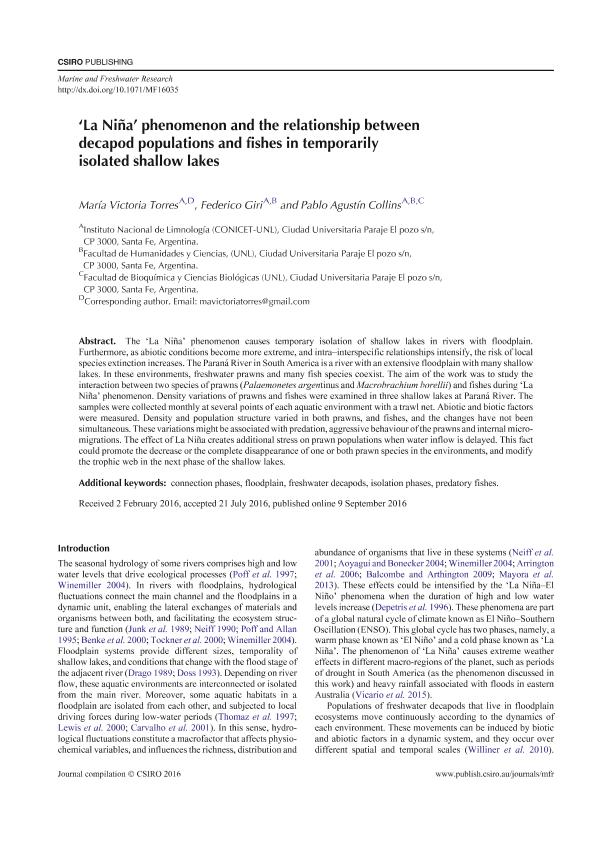Mostrar el registro sencillo del ítem
dc.contributor.author
Torres, María Victoria
dc.contributor.author
Giri, Federico

dc.contributor.author
Collins, Pablo Agustin

dc.date.available
2018-09-16T14:24:36Z
dc.date.issued
2016-09
dc.identifier.citation
Torres, María Victoria; Giri, Federico; Collins, Pablo Agustin; 'La Niña' phenomenon and the relationship between decapod populations and fishes in temporarily isolated shallow lakes; Csiro Publishing; Marine and Freshwater Research; 68; 6; 9-2016; 1010-1022
dc.identifier.issn
1323-1650
dc.identifier.uri
http://hdl.handle.net/11336/59817
dc.description.abstract
The 'La Niña' phenomenon causes temporary isolation of shallow lakes in rivers with floodplain. Furthermore, as abiotic conditions become more extreme, and intra-interspecific relationships intensify, the risk of local species extinction increases. The Paraná River in South America is a river with an extensive floodplain with many shallow lakes. In these environments, freshwater prawns and many fish species coexist. The aim of the work was to study the interaction between two species of prawns (Palaemonetes argentinus and Macrobrachium borellii) and fishes during 'La Niña' phenomenon. Density variations of prawns and fishes were examined in three shallow lakes at Paraná River. The samples were collected monthly at several points of each aquatic environment with a trawl net. Abiotic and biotic factors were measured. Density and population structure varied in both prawns, and fishes, and the changes have not been simultaneous. These variations might be associated with predation, aggressive behaviour of the prawns and internal micro-migrations. The effect of La Niña creates additional stress on prawn populations when water inflow is delayed. This fact could promote the decrease or the complete disappearance of one or both prawn species in the environments, and modify the trophic web in the next phase of the shallow lakes.
dc.format
application/pdf
dc.language.iso
eng
dc.publisher
Csiro Publishing

dc.rights
info:eu-repo/semantics/openAccess
dc.rights.uri
https://creativecommons.org/licenses/by-nc-sa/2.5/ar/
dc.subject
Connection Phases
dc.subject
Floodplain
dc.subject
Freshwater Decapods
dc.subject
Isolation Phases
dc.subject
Predatory Fishes
dc.subject.classification
Otras Ciencias Biológicas

dc.subject.classification
Ciencias Biológicas

dc.subject.classification
CIENCIAS NATURALES Y EXACTAS

dc.title
'La Niña' phenomenon and the relationship between decapod populations and fishes in temporarily isolated shallow lakes
dc.type
info:eu-repo/semantics/article
dc.type
info:ar-repo/semantics/artículo
dc.type
info:eu-repo/semantics/publishedVersion
dc.date.updated
2018-09-14T13:21:30Z
dc.journal.volume
68
dc.journal.number
6
dc.journal.pagination
1010-1022
dc.journal.pais
Australia

dc.journal.ciudad
Collingwood
dc.description.fil
Fil: Torres, María Victoria. Consejo Nacional de Investigaciones Científicas y Técnicas. Centro Científico Tecnológico Conicet - Santa Fe. Instituto Nacional de Limnología. Universidad Nacional del Litoral. Instituto Nacional de Limnología; Argentina
dc.description.fil
Fil: Giri, Federico. Consejo Nacional de Investigaciones Científicas y Técnicas. Centro Científico Tecnológico Conicet - Santa Fe. Instituto Nacional de Limnología. Universidad Nacional del Litoral. Instituto Nacional de Limnología; Argentina
dc.description.fil
Fil: Collins, Pablo Agustin. Consejo Nacional de Investigaciones Científicas y Técnicas. Centro Científico Tecnológico Conicet - Santa Fe. Instituto Nacional de Limnología. Universidad Nacional del Litoral. Instituto Nacional de Limnología; Argentina
dc.journal.title
Marine and Freshwater Research

dc.relation.alternativeid
info:eu-repo/semantics/altIdentifier/doi/http://dx.doi.org/10.1071/MF16035
Archivos asociados
